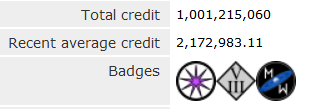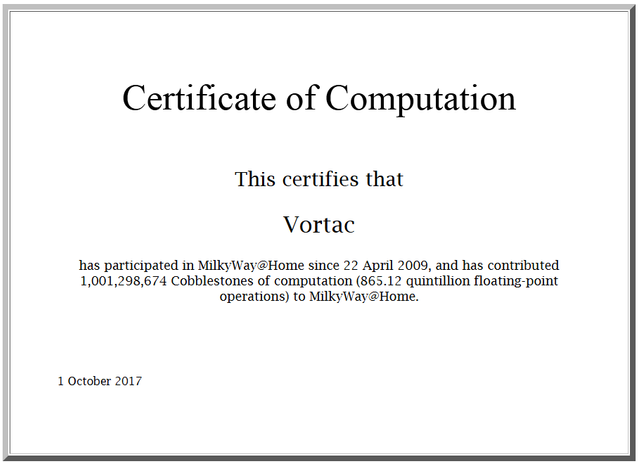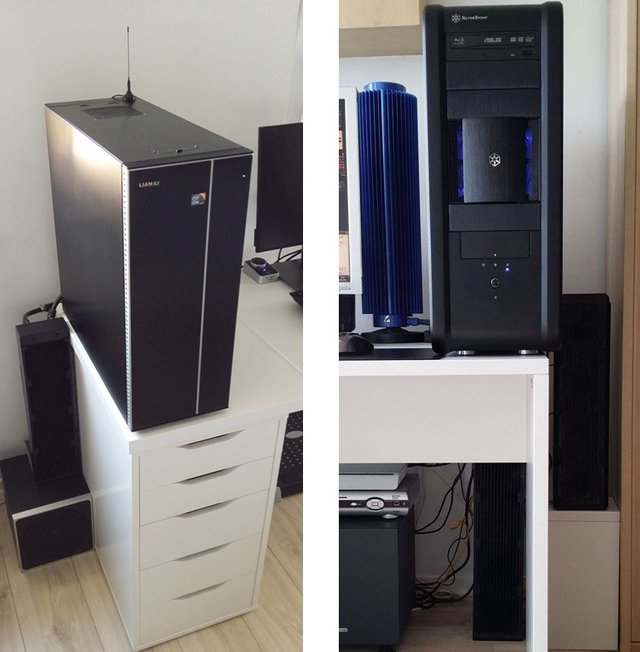One Billion MilkyWay@Home Credits or How Did We Get To Know That Galaxy is Rippled
I've been crunching SETI@home and BOINC since 1999 and participated in many different scientific projects with my PCs, but never reached the One Billion Credits Milestone for any particular one. Well, today is that day! I am proud to announce breaking the 1B barrier for MilkyWay@Home - a BOINC project which is using volunteered computing resources around the world to create a highly accurate three dimensional model of the Milky Way galaxy.

MilkyWay@Home has computed: our Galaxy is corrugated. Why and how... still being researched. One thing that's 100% sure - more computing power is needed (as you can probably imagine, it isn't easy to map the Galaxy). You can contribute too.
The Badges

Most BOINC projects issue some kind of badges to mark important milestones achieved (they are visible through your account). My badges so far, from left to right:
Purple Star - One Billion credits badge
Roman VIII - eight years of crunching for MilkyWay@Home
M/W - Special Contribution Badge (you get this one when you donate some money to MilkyWay@Home, they were without government funding throughout 2015, but they received another NSF research grant in 2016, so they are well-funded now and not accepting donations for the time being).
Full list of MilkyWay@Home badges is available here.
Certificate of Computation
Every BOINC project allows you to create a "Certificate of Computation" with some stats about your contribution. MilkyWay@home estimates I have contributed 865.12 quintillion floating-point operations to their project so far (865 exaFLOPs or 8.65x10^20 floating point operations). I guess only the most hardcore geeks are familiar with quintillions (I had to look it up too) so, in more commonly used teraflops, that's 865 million TFLOPs (8.65x10^8 TFLOPs). True geeks will be even more impressed knowing those are exclusively FP64 operations or so called 'double precision' (MilkyWay@home is one of the few BOINC projects which require FP64 capabilities). FP64 computations are usually more expensive and harder to obtain, requiring professional GPUs nowadays.

One HD7970 is able to achieve 1.1 TFLOP per second on stock clocks (in FP64) and I've been running six of them overclocked for years now (plus some other hardware). Overall, I find that 865 quintillion FLOPs is an accurate enough estimate of my contribution.
Power Consumption and Hardware
So how many watts for such niceties? A lot, as you can probably imagine. I estimate I have spent around 50 megawatt-hours over the years, for MilkyWay@Home. I am currently running six GPUs (HD7970s) placed in two PCs in my living room, dumping up to 2000 watts of heat during the winter (heaviest, Beyond The Edge overclock). So at least I saved a lot on heating bills during the winters :)

Here they are, six watercooled HD7970s. They are now five years old (i.e. ancient), but still among the best for MilkyWay@Home, due to low price and high FP64 performance.

Looks normal enough, when fully assembled and with cases neatly closed - you can map the Galaxy in your living room too! Alright, that blue cylinder (reservoir) is somewhat unusual, but it's shiny enough to look nice :)
The crypto aspect of it
In addition to saving on heating, you can also offset your costs by minting Gridcoin, a cryptocurrency which is rewarding BOINC computations (MilkyWay@Home included). It's simple enough: more computational science -> more BOINC credits -> more Gridcoins. With six HD7970s, you can easily mint 100-110 GRC daily (I am still ramping up after the summer), worth about $4 at current (low) prices. Average price of one kilowatt-hour at my place is about 11 cents, so I can buy around 36 kWh with $4. Running at more or less default clocks, my 7970s consume about 1500 watts or exactly 36 kWh per day, so despite current low prices (1 GRC=3.5 cents currently) I am still running even and Gridcoin is paying 100% for my electricity (although it hasn't recovered yet from the recent drop, caused by worries over Bitcoin).
A Small Cog in The Big Wheel
My contribution, however large, is just one small part of the Team Gridcoin, which is again one small part of the whole BOINC network. In fact, I am only 14th on the list of top MilkyWay@Home participants (ranked by total credit). Top cruncher there has amassed 4.7 billion credits - extrapolating my numbers, he is approaching 0.25 gigawatt-hours in power consumption. As you can see, competition in computational science is sometimes tougher than in Proof-of-Work mining, precisely because you are not computing some meaningless hashing stuff, but actual cutting-edge science.

This is very interesting. I will have to look into it some more... Saving money always sounds good to me :)
Yo Trumpman, what is this? I like the concept.
here's a brief overview, https://steemit.com/science/@steemstem/an-update-on-the-steemstem-project although much have happened since, including getting support from curie: https://steemit.com/curation/@curie/curie-weekly-update-10th-september-to-17th-september-2017-major-update-inside
You can always join the chat too find out more :)
Congrats Vortac - a massive milestone in the field of distributed compute! If only all miners spent their clock cycles on BOINC computations instead of mining POW coins... The world would be a much better place.
I hope that as more people begin to realise the futility of their mining 'work' we will see a greater adoption of Gridcoin and BOINC. The achievements that would enable (thanks to modern compute power) in the fields of medicine, mathematics and astronomy are beyond the scope of anything we have seen before.
Even more impressive is that you completed those FLOPs in FP64! On a modern GeForce card, those 865 quintillion FP64 FLOPs would be equivalent to 27.7 sextillion FP32 FLOPs, which all the other projects and applications such as video games use. Insane!
Thanks Dutch. Looking forward to crunch for your project(s) one day.
Very interesting article. It is neat to see your setup. Mine is just a couple regular pcs with a run of the mill video card. I still mint about 1.5 per day I think. Good clean fun. :)
Simply amazing what you have done since long man!
Congratulations for the performed and future work.
Please, keep posting your experiences here we want to learn from the saviors.
Thanks for sharing.
wow! you are amazing!! thank you :) i just stated my boinc - but i will catch up to you guys on one of this years :)))
😂👍🏻 this is the attitude man!!!
Great Job Vortac! You've been crunching BOINC since 1999?! Damn! You're quite the veteran. Here's to another billion credits and to another 8 years of crunching!
Since 20 Sep 1999! It passed quickly :)
Of course, BOINC didn't exist yet in 1999, it was SETI@home only then (standalone). Later, it grew into BOINC and SETI@home itself switched to it.
Here's my SETI@home account:
https://setiathome.berkeley.edu/show_user.php?userid=52278
rather than looking at altruism why don't you mine the most profitable PoW coin and then support the Boinc / gridcoin network with your earned money? Wouldn't it be more helpful from a strict economical sense? if the reward is the same between the highest reward pow coin and the boinc projects, hashes will go towards the most profitable. And this is fact.
I prefer my account and name associated with scientific discoveries and breakthroughs rather than with some crappy hashes.
yeah but with a more efficient way of making money you could buy gridcoins and support more efficient miners ;).
They don't need my support, BOINC had millions of users before Bitcoin was even invented. If all PoW coins magically disappeared tonight, BOINC would carry on as usual tomorrow (and would probably grow much faster afterwards). It's the PoW miners who need computational science and distributed computing for solving some major problems of the modern world today, not the other way around.
Legend :-)